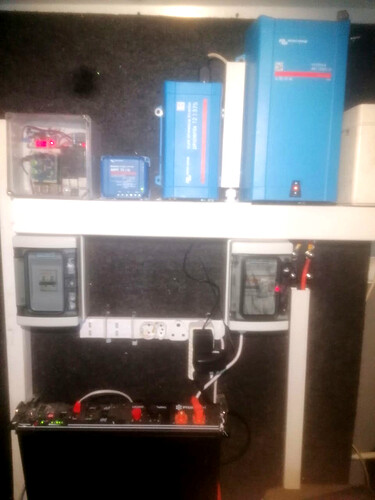This is a crazy “inefficient” inverter system I have build into my vehicle. I am on the road a lot and need stuff like a fridge, microwave and internet. I use to run some of it off the battery, but over weekends when i dont drive that much i ran into a few problems and ended up damaging a normal battery to a point that it needed replacement. I use to run a Victron Phoenix 375VA inverter straight from the battery, but use to forget to switch of the system when I stopped for the night or weekend and ended up with a flat battery on many occasions.
I always end up with extra components every time I upgrade systems for clients. These extra spares came in handy when I decided to build the following system.
Components used:
2 x Raspberry Pi 4’s (Bought two years back to play with, never found a permanent work for them)
1 x 75/15 MPPT (Bought from Client when upgrading his system)
1 x 375va Phoenix (Bought for vehicle)
1 x 1200VA Multi (Bought from client when upgrading her system)
1 x US2000 Pylontech (I replaced a faulty Pylon and received this one after it had been replaced)
I decided to use an old second hand 75/15 MPPT to monitor the battery voltage, when the voltage goes higher than 13.5Volts the MPPT switches on its output, I connected a 12volt relay and a 12v-5volt converter to this output. The relay is then used to switch on the Phoenix inverter and the 12-5volt converter is used to power a Raspberry Pi with Venus OS on it. So Pi 1 is used to monitor the 12volt system. When i shut down the vehicle and the Voltage drops below 13.5 Volts the outputs is switched off and the Phoenix stops feeding power to the multi.
The 220Volt output of the Phoenix is then connected to the N/C contacts of another relay and an extension lead that is used to connect the system to the grid when the vehicle is stationary is connected to the N/O as well as the Coil of the relay. The input of the 1200VA 48Volt multi is then connected to the Common terminals of this relay. When driving normally, the output of the Phoenix is feeding through the N/C contacts into the Input of the Multi and the multi starts charging the Pylontech. When I connect the grid to the system via a 3 point plug, the voltage will energise the coil and the Grid power will feed into the multi through the N/O contacts of the relay.
There is a 92L National Luna Fridge, a Router, a second Raspberry PI with a Can Hat for monitoring the 48volt system and a microwave connected to the 48 volt system. The lithium can keep the Fridge and Router and the PI live for up to 60 Hours without a charge. Driving to work and back every day produces enough charge to keep the battery pretty close to full. On weekends I connect grid to the system to ensure having a full charge before the next weeks driving.
The Last benefit of this system, If i forget the lights on and the battery runs down, I connected the 48 volt from the Pylon to the PV input of the MPPT. I just need to switch on a breaker and the 12Volt battery in the vehicle gets charged from the Pylontech.
I know its not the most efficient way to charge a battery, but we are on the road so much that i might as well use the alternator as long as its running.
